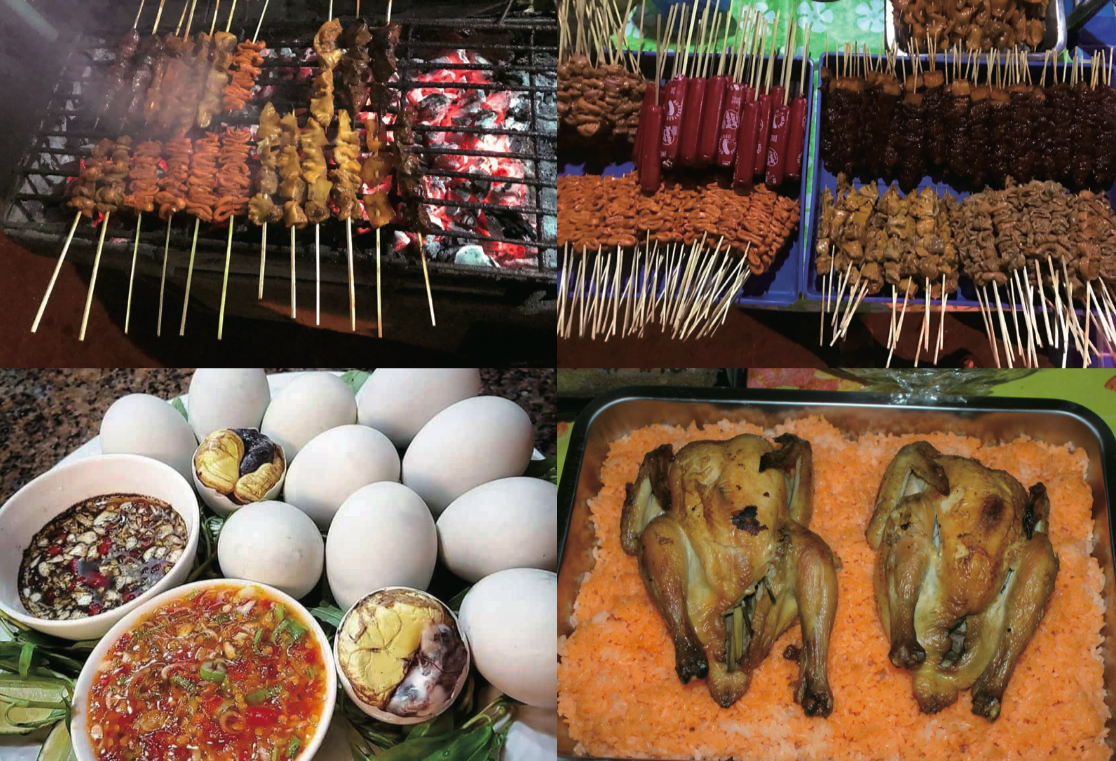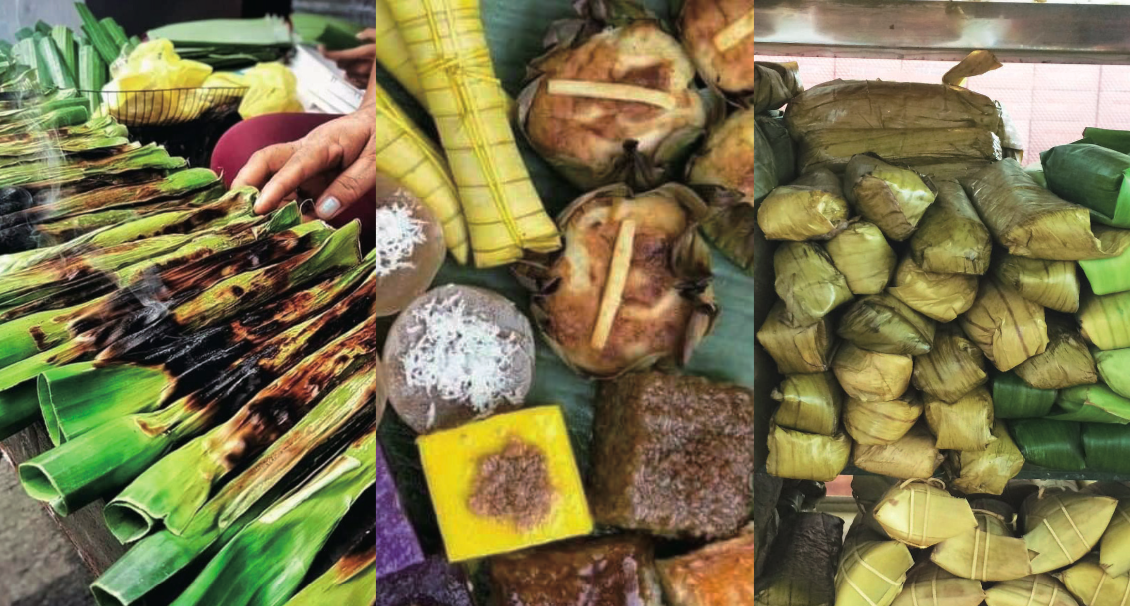Philippine cuisine features plentiful servings of vegetables, seafood, meat, appetizers, and sweets that are usually served after the meal.[i] The variety on the Philippine menu is due to natural adaptation and Filipinos’ history with their Asian neighbors and traders during the pre-colonization era before the 15th century. Through these experiences, Filipinos acquired the knowledge of using native herbs and cooking techniques that highlight the savory flavors in many dishes. Some of the common methods of cooking Filipino food include:
- Adobo or simmering meat in a marinade of soy sauce, vinegar, and spices; or roasting nuts or vegetables with soy sauce and garlic in a pan
- Atchara or pickling vegetables
- Banlian or blanching food
- Binalot or wrapping food in banana leaves
- Binangoongan or adding bagoong (shrimp paste) to a dish, either during cooking, or as a dip
- Binuro or fermenting food
- Daing or drying meat, mostly fish, under the sun, and fried
- Ginataan or cooking with gata (coconut milk)
- Gisa or sautéing with onion, garlic, and sometimes tomato
- Halabos or steaming shellfish with lemon
- Inihaw or grilling over direct heat of the charcoal
- Kilaw or preserving fish meat using a mild acid such as vinegar or lime juice
- Laga or boiling food
- Lechon or roasting meat on a spit over an open fire
- Lumpia or wrapping savory food with a spring roll wrapper, then deep fried
- Minatamis or cooking food in sugar
- Nilasing or cooking food with spirits, such as beer or tuba (sugarcane alcohol)
- Paksiw or cooking food in vinegar
- Palaman or stuffing or filling (in a sandwich)
- Pasingaw or steaming food
- Pinikpikan or a brutal way of preparing meat where the animal is beaten to death with a stick before being cooked
- Pininyahan or cooked or marinated with pineapple juice
- Prito or (deep) frying in oil
- Relleno or stuffing, usually done in bangus (milkfish) but also chicken
- Sangag or stir-frying rice with garlic
- Sarciado or cooking with thick sauce, usually with tomato
- Sariwa or serving food fresh and uncooked
- Sigang or cooking in a soup with a sour base such as sampalok (tamarind) or calamansi (Philippine lime)
- Silog or pairing meat with sinangag (si) and itlog (log) or egg
- Tapa or marinating meat, then drying it before frying
- Tinapa or drying fish
- Torta or cooking with eggs in a manner like an omelet
- Turon or wrapping fruits such as banana or jackfruit with an edible wrapper, then deep fried
- Tusta or toasting

How to Eat and Drink Like a Filipino
In most Filipino households, there are three main meals a day, starting with agahan or almusal (breakfast), tanghalían (lunch), and hapunan (dinner). Many Filipinos also have a snack called merienda or minandal, a custom that comes from the Spanish, that can take place between breakfast and lunch or lunch and dinner.
Almusal (breakfast) usually consists of leftovers from the previous evening’s dinner. As Filipinos are known for being resourceful, they fry bahaw or leftover steamed rice with garlic to make sinangag. This garlic fried rice is usually served together with a fried sunny side up egg and some form of meat such longganisa or sausage, corned beef, tapa or tocino (two types of Filipino cured meat), or tuyo (dried salted fish), along with whatever viand is left from dinner the day before. Lunch and dinner viands may vary from vegetables, meat, or seafood or a combination of these three. All dishes are typically accompanied by white rice. For merienda, light snacks can be sweet such as turon (a deep-fried banana spring roll) or savory such as squid balls, fish balls and the like.
The traditional way of eating Filipino food is with bare hands, through pinching or taking a bite of the viand, then scooping a sufficient amount of rice together with fingers. Banana leaves, spread out on the table, function as a plate.
Rice is an “essential survival food”[vi] in Filipino cuisine and is often enjoyed with sauce or broth from main dishes. It can be cooked through steaming, then served with meat, seafood, or vegetables. Sinangag, or stir-fried rice with garlic, is another popular rice dish and is served usually for breakfast. In some regions, rice is often enjoyed with coffee when eating fried dishes at the same time. Another Filipino comfort food normally prepared for breakfast and during the rainy season is lugaw, or porridge made from rice and mixed with various meat.
Desserts made from glutinous rice cakes and cassava roots are collectively known as kakanin and range from biko, kutsinta, puto, sapin-sapin and suman to sweets mixed with shredded coconut like karioka, palitaw, pitsi-pitsi, and binatog. In Philippine culture, sticky rice cakes symbolize cohesiveness in the family.[vii] Champorado (malagkit or sticky rice with cocoa) is a common dish best served with dilis or salted dried anchovies or some other type of dried salted fish such as tuyo.

Due to the tropical climate of the Philippines, Filipinos prefer to cool down with chilled drinks and desserts, or an overlap such as halo-halo[viii], an assortment of sweet condiments topped with shaved ice and milk. Other cold desserts include mais con yelo (sweet corn with shaved ice), saba con yelo (banana with shaved ice), and buko pandan. Sorbetes or dirty ice cream is popular whole year-round, while ice candy, a frozen milk juice flavored with tropical fruits, is widely known as being easily prepared and less expensive. Meanwhile, samalamig (cold fruit drinks) fruit shakes, sago’t gulaman (pearl bubbles and gelatin) and fresh coconut juice stands are available almost everywhere throughout the country.
Coffee is a regular part of the Filipino meal. Different regions offer a variety of coffee such as kapeng barako, kape alamid, and kape musang. In the province of Batangas where kapeng barako originates, coffee is often served alongside all meals.
Alcoholic beverages are also popular in festivities all over the country.[ix] Some of the widely commercialized alcoholic drinks in the Philippines are beer, rum, and gin, as well as traditional alcoholic drinks such as laksoy (bitter nipa palm liquor from Butuan in Mindanao)[x], lambanog (distilled palm liquor from the Quezon Province)[xi], tapey (rice wine from the Mountain Province)[xii], tuba (made of coconut sap), and basi (fermented sugar cane from the northern Ilocos region).[xiv] These alcoholic beverages are partnered with pulutan (finger food or hors d’oeuvre, from the Filipino word pulot or “to pick up [food]”).
A drinking session is called tagayan, from the Filipino word tagay (“cheers” or “toast”), and it is mostly loud and full of music from karaoke. Tagayan is said to originate from Quezon Province where tanggero (“drinking buddies”) welcome visitors and friends.[xv] The celebratory moods during a tagayan are traced to the ancient beliefs that heaven is a life full of celebration and constant eating and drinking with ancestors. But Filipino author Alejandro Roces clearly articulates the reasons why Filipinos drink: “We drink when we are very happy. We drink when we are very sad. And we drink for any other reason.”

Works Cited
[i] Alejandro, R. (1985). The Philippine Cookbook. New York: The Berkley Publishing Group.
[ii] Fernandez, D. (1998). Philippine Food. Pahiyas: A Philippine Harvest, 51-52.
[iii] Macaalay, R. (2018, March 29). Filipino Cuisine Cooking Methods. Retrieved September 2019, from Ang Sarap.
[iv] Altarep, M. (2012, December 4). Filipino Cooking Methods II. Retrieved September 2019, from Filipino Cooking.
[v] Polistico, E. (2016). Philippine Food, Cooking, & Dining Dictionary. Mandaluyong City, Philippines: Anvil Publishing.
[vi] Stuart, G. U. (n.d.). The ABCDE of Philippine Cuisine: A Culinary Opinion. Retrieved September 2019, from stuartxchange.
[vii] Oldham, G. (2015). The Filipino American Experience: Filipino American Restaurants and Cuisine. In G. Oldham, H. Ling, & A. Austin (Eds.), Asian American History and Culture: An Encyclopedia (p. 303). New York: Routledge.
[viii] Esterik, P. V. (2008). Typical Meals. In P. V. Esterik, Food Culture in Southeast Asia (pp. 53-77). Westport, Connecticut: Greenwood Publishing Group.
[ix] Caballar, R. D. (2016, September 1). How We Drink in the Philippines. Retrieved October 2019, from Medium.com.
[x] Ibid.
[xi] Ibid.
[xii] Ibid.
[xiii] Filipino Drinking Culture. (2016, December 11). Retrieved October 2019, from Philippine Primer.
[xiv] Ibid.
[xv] Ibid.
[xvi] Fenix, M. (2019, January 10). The Filipino culture of drinking continuously. Retrieved October 2019, from Philippine Daily Inquirer.
[xvii] Roces, A. (1948, November 6). We Filipinos Are Mild Drinkers. Evening News Saturday Magazine. Retrieved Evening News Saturday Magazine November 6, 1948, from Malacanan Palace Presidential Museum & Library.

This article first appeared in the Kain na, Kabayan: The Kusina ni Kabayan Philippine Cookbook.
Email kusinanikabayan@gmail.com to get your copy.
Written by Abhigail Gatdula-Xu and Ann Katrina Sagum
Photos: Jensen Moreno, Gil Librado
